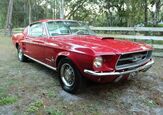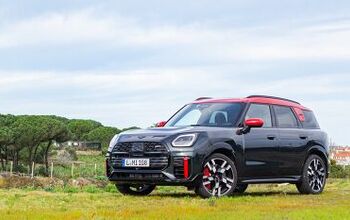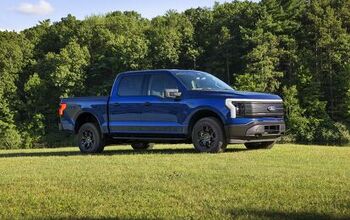First Drive Review: 2025 MINI Cooper S And JCW Convertible

The MINI Convertible family is all-new for a fourth generation in 2025, with three distinct models for North America: Cooper (Cooper C in Canada), Cooper S, and John Cooper Works (JCW). These cars come with fresh styling that’s still recognizably MINI, with bug-eyed LED lights, a big open-mouth front grille, and more body and accent color combinations than you can shake a stick at.
More powerful turbo four-cylinders up the MINI Convertible performance game, while refreshed interiors with new tech—delivered in quirky MINI style—add flair and sophistication.
AutoGuide recently traveled to Savannah, Georgia, to sample the Cooper S and JCW drop tops—here’s what we learned.
Quick Take
The MINI Cooper S Convertible and John Cooper Works Convertible look like street-legal go-karts, and that’s exactly how they perform. Twitchy, fast, and fun. The fourth gen comes with a slick operating soft top, updated styling, and new tech, but the soul of these cars remains the same: all-out fun.
2025 MINI Cooper S And JCW Convertible: All The Details
What’s New For 2025
The MINI Cooper S Convertible and John Cooper Works Convertible are all-new four a fourth generation in 2025, with a fresh design, new tech, and more power. Despite the changes, these cars remain faithful to a fun, vibrant, and sporty aesthetic that is core to the MINI brand.
Exterior Style
Both cars retain a familiar MINI face, with round LED headlights and redesigned octagonal shaped grille. Lighting signatures, available in three styles, feature walk-up and walkaway animations, with MINI logo projections on the ground on both sides of the car. At the rear, vertically stacked LED taillights dominate, along with a large model badge.
As they were before, both cars feature a long wheelbase despite their small size, with short front and rear overhangs.
Standard wheel size is 17-inch, but 18-inchers are available. Generally, the changes feel incremental, making the design’s clean lines and sharp detailing appear instantly recognizable.
In MINI tradition, a broad array of exterior colors and accents enable owners to customize their MINI Convertibles in numerous ways, which synchs well with the brand’s “Always Open” philosophy.
Speaking of open, the power soft top, which is available in Union Jack flag pattern, opens fully in 18 seconds at speeds up to 19 mph. The roof can be opened two ways – fully retracted, or like a sunroof, where it can slide to a maximum of 16 inches regardless of how fast the car is traveling.
Powertrain and Fuel Economy
Powering all MINI Cooper S Convertible is a 2.0-liter turbocharged four-cylinder engine that produces 201 horsepower and 221 foot-pounds of torque, which can scoot from 0-60 mph in just 6.7 seconds. Paired with the 2.0-liter turbo is a seven-speed dual-clutch automatic that drives the front wheels.
The range-topping John Cooper Works Convertible is powered by a 2.0-liter twin-turbo four-cylinder mill that cranks out 228 horsepower and 280 lb-ft. of torque. The big news here is the torque bump, which is up from 235 lb-ft. to 280, and the extra oomph is noticeable, especially at launch. And the JCW Convertible feels fast, too, which the stopwatch confirms. It scoots to 60 mph from rest in 6.2 seconds.
Bottom line, both engines provide plenty of zip and buzz under hard acceleration, but the JCW twin-turbo delivers more bap-bap-bap off-throttle excitement, if that’s what you’re into.
Fuel economy figures for the U.S. are 26 city / 36 highway for the Cooper S Convertible and 26 / 35 for the John Cooper Works Convertible. For Canada, the Cooper S Convertible is rated at 8.9 L /100 km in the city and 6.6 on the highway, while the JCW is rated at 9.0 / 6.6.
Ride Quality and Comfort
MINI has long exuded go-kart energy—these cars even have a go-kart drive mode!—and it persists in all the cars I drove in Savannah. This is most true for JCW, but Cooper S is no slouch, either. Both cars have a darty, twitchy road feel, where even small steering inputs can send them careening in another direction. Highly preloaded anti-roll bar mounts at the axles are the main reason for such a precise steering feel, according to MINI.
Both models are tuned for a sporty feel and agile handling, and that certainly was the case on smooth, choppy, and undulating tarmac in and around Savannah. While the cobblestone sections in town and the multiple level-cross rail lines were bumpy, they didn’t bump our test cars off course. And on the smooth stuff, forget it—these MINIs feel like they’re on rails. Word to the wise—keep the steering inputs gradual because the response, especially in the JCWs, is hair-trigger.
Top down, wind buffeting wasn’t too severe, provided the side windows are up. It’s more difficult to have a conversation with a front-seat passenger when the windows are down, but that’s true for all convertibles.
Interior Style and Quality
MINIs have long had quirky interiors, and that’s very much the case here. Oh, look, a console box that will hold a single soda can on its side! Look at those toggle switches for… uh… oh right… engine start/stop, and “experiences”. What are experiences, you ask? They’re drive modes. The experiences toggle is for drive modes. Hope you don’t have big fingers because the gear selector is tiny! And park is on a separate button. Why? Don’t ask; just enjoy British whimsy!
What’s impressive about the MINI cabin is how both spartan and intentional the design feels. If you’re someone who doesn’t want to fiddle with too much, MINI is your kind of car. Because, apart from the touchscreen, which we’ll get into further down, there’s not much to adjust.
Once you adjust the seating position and mirrors, there’s not much else to do. The beefy new steering wheel has some functionality, but not too much. I used the volume up/down buttons, but that was it. Other stuff can be adjusted, but this wheel doesn’t invite distraction, which is a plus.
What stands out to me are comfortable vegan leather and cloth seats, which are available in four color schemes, and smaller details like the fabric dashboard, and a-pillar mounted Harman / Kardon speakers, and vertical cell charge pad that stands your smartphone up so you’re less likely to forget it when exiting the car. As someone who forgets his cell phone in cars with some regularity, this charge pad design is a nice, detailed touch I really appreciate.
Tech and Safety
The main tech attraction in new MINIs these days is the 9.4-inch OLED center display. This circle panel looks like a digital pizza but is admittedly cool to look at, with its massive color gamut, pin-sharp resolution, and generally cheeky aesthetic. It can display a broad array of info in a clean and crisp manner, but what I really love is how its theme changes when the experiences toggle is adjusted. Such as when I put the car into Go-Kart mode, and checkered flags appear, along with a tachometer and a sporty chime. Personal mode allows users to change the main display background to a personal photo, which can be uploaded via the MINI app. Very cool.
The MINI Intelligent Personal Assistant, which can be summoned via, “hey MINI!” voice command or via the steering wheel's push-to-talk button, is making its debut in MINI Convertibles. It can be used for the usual items such as navigation, telephone functions, entertainment, and other vehicle functions.
All MINI Convertibles can be outfitted with Driving Assistant Plus Package which comes with Steering and Lane Assistant. Parking Assistant Professional, which uses 12 ultrasonic sensors and four Surround View cameras, is also available.
Value Dollars and Sense
American pricing for the 2025 MINI Cooper S Convertible starts at $37,200, while the John Cooper Works Convertible starts at $43,700, plus $1,175 destination. For Canada, the Cooper S Convertible starts at $46,990 CAD, while the JCW Convertible begins at $58,990 CAD, plus $2,555 CAD destination.
Final Thoughts: 2025 MINI Cooper S Convertible / JCW Convertible
What can we say? One look at the 2025 MINI Cooper S Convertible and John Cooper Works Convertible makes you want to get behind the wheel, drop the top, and cruise into an infinite horizon. And if you want to get wherever you’re going in a hurry, these MINIs stand ready.
Frankly, there’s not much we don’t love about these cars. Sure, we wish there was a manual transmission option, but we get why that isn’t the case. And yes, the circular infotainment screen, while dazzling, can be a bit tricky and distracting to navigate. It’s also true that there isn’t much cargo capacity either.
But honestly, when the wind is tossing your hair, the music is up, and you’re slicing through traffic in Go-Kart mode, will these drawbacks matter much? We don’t think so, either.
Become an AutoGuide insider. Get the latest from the automotive world first by subscribing to our newsletter here.
Pros | Cons |
|---|---|
Spicy performance | Infotainment screen can be tricky to navigate |
Iconic design | Small cargo spcae |
Quirky character | No manual transmission |
Engine / Motor | 2.0L turbo I4 / 2.0L twin-turbo I4 |
Output | 201 hp / 221 lb-ft. (228 / 280 – JCW) |
Drivetrain | FWD |
Transmission | 7-speed DCT |
Fuel Economy MPG | 26 city, 36 highway (35 – JCW) |
Fuel Economy L/100 km | 8.9 city (9.0 – JCW), 6.6 highway |
Starting Price USA | $37,200 / $43,700 (JCW) |
Starting Price Canada | $46,990 / $58,990 (JCW) |
As Tested Price USA | $41,900 / $48,700 (JCW) |
As Tested Price Canada | $52,390 / $58,990 (JCW) |

With more than 20 years of industry experience, which includes automotive retail, motorsports PR, and writing and editing for various automotive publications, Lee is an AutoGuide freelancer, and car guy to the core. For nearly a decade and a half, he has married his two consuming passions together – journalism and the automotive industry. Whether it’s providing coverage on debuts from an auto show floor, writing road test reviews, or previewing a new model coming soon, Lee is eager to share his passion for the automotive industry with his readers. He is a long-standing member of the Automobile Journalists Association of Canada (AJAC) and won a feature writing award in 2018.
More by Lee Bailie







































Comments
Join the conversation
The 2025 MINI Convertible lineup proves you really can evolve without losing your soul. MINI nails the balance between quirky charm and modern upgrades—those LED walk-up animations and the Union Jack soft top are such fun touches. The Cooper S and JCW sound like an absolute blast to drive—go-kart vibes with more power and sharper style? Yes, please. Glad to see MINI staying true to its playful roots while giving us the tech and performance we expect in 2025.
Sam
https://www.necs-limo.com